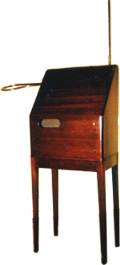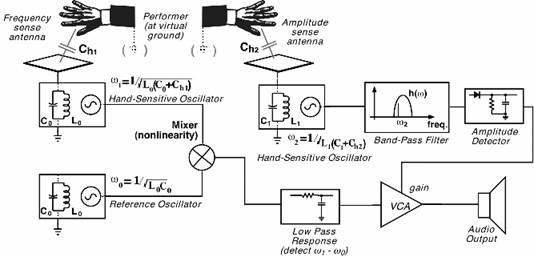contact
MOMus
Museum of Modern Art
Costakis Collection
21 st Kolokotroni Str.
Moni Lazariston
56430, Stavroupoli
Greece
Theremin. Summary of Operating Principle |
|
Pitch is changed by capacitance of your hand, or whatever goes close to the antenna. The Theremin has two very high frequency oscillators (around 350 kHz). One of them is fixed, and the other is varied by the capacitance of your hand: it's the difference between the two frequencies which decides the pitch. That way, even a 0.05% change in the variable oscillator can be substantial at audio frequency - enough, with good design, to give a range of five octaves.
Thus the audio frequency note is produced by heterodyning the outputs of two ultrasonic oscillators. The fixed oscillator operates in the region of 350 KHz with the variable pitch oscillator being above this frequency, the difference equaling the frequency of the note being played. The position of the right hand is sensed by the change of capacitance it introduces in the pitch antenna, this change controls the frequency of the variable pitch oscillator. Left hand circuitry derives a control voltage from the loudness antenna, this voltage being used to control the gain of the voltage controlled amplifier and hence the amplitude of the output. The resulting sine wave output is processed to give more complex waveforms which provide a choice of tone colors in addition to the pure sine wave tone. | |
|
Learn More:
Extra Links:
|
|
 The THEREMIN (aka Theremin-vox) is one of the most distinctive of all electronic instruments. It was invented in 1919 by Russian physicist and musician Lev Sergeyevich Termen, whose name somehow became French-ified to Leon Theremin. It has a unique sound, and a unique design. It's also one of the very few instruments you play without touching. Instead of a keyboard, or strings, it has antennas which sense the movements of your hands in the surrounding space. Those antennas provide a control of pitch and loudness. The pitch antenna is a vertical rod situated in front of the player and slightly to the right. The loudness antenna is placed to the left and fashioned into a horizontal loop so as to be under the horizontal palm of the player's left hand. Movement of the right hand toward the pitch antenna controls pitch, while movement of the left hand toward the volume antenna controls loudness or volume.
The THEREMIN (aka Theremin-vox) is one of the most distinctive of all electronic instruments. It was invented in 1919 by Russian physicist and musician Lev Sergeyevich Termen, whose name somehow became French-ified to Leon Theremin. It has a unique sound, and a unique design. It's also one of the very few instruments you play without touching. Instead of a keyboard, or strings, it has antennas which sense the movements of your hands in the surrounding space. Those antennas provide a control of pitch and loudness. The pitch antenna is a vertical rod situated in front of the player and slightly to the right. The loudness antenna is placed to the left and fashioned into a horizontal loop so as to be under the horizontal palm of the player's left hand. Movement of the right hand toward the pitch antenna controls pitch, while movement of the left hand toward the volume antenna controls loudness or volume. 